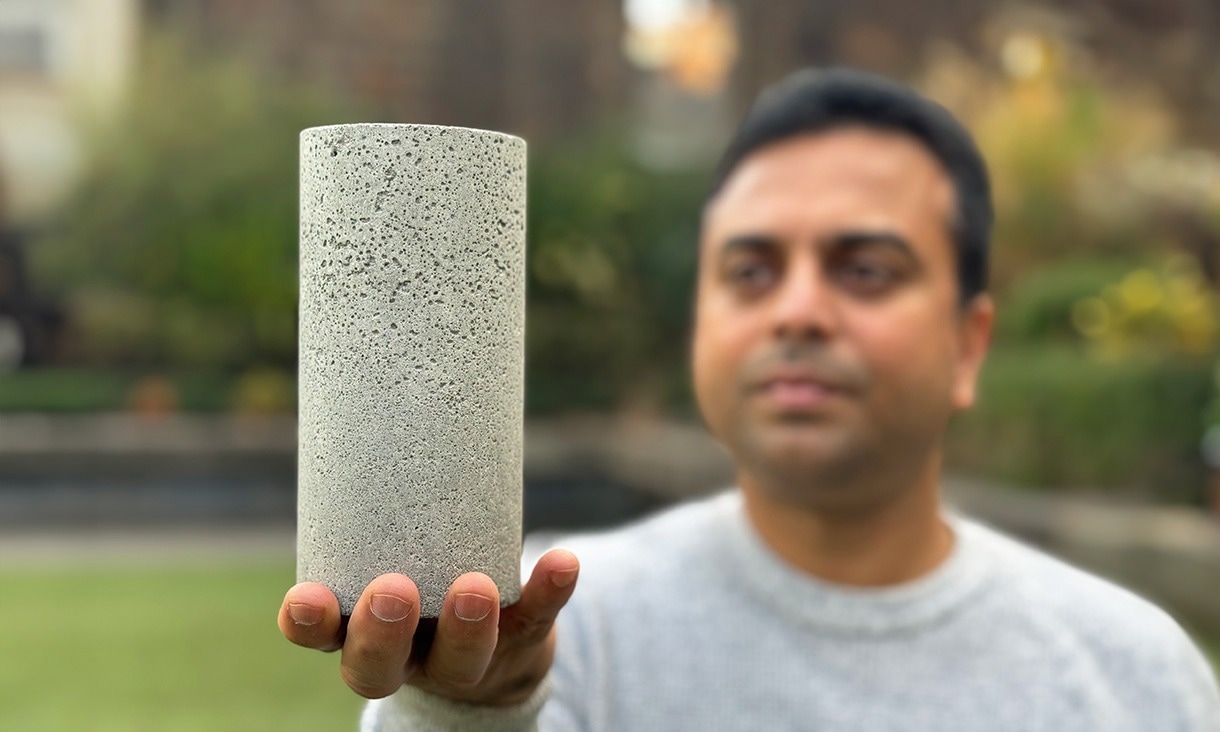RMIT’s pilot computer modeling software, created in collaboration with Dr. Yogarajah Elakneswaran of Hokkaido University and detailed in the journal Cement and Concrete Research, is now being utilized to estimate the time-dependent performance of innovative concrete mixtures.
 Dr. Chamila Gunasekara holds a sample of the low-carbon concrete. Image Credit: Michael Quin, RMIT.
Dr. Chamila Gunasekara holds a sample of the low-carbon concrete. Image Credit: Michael Quin, RMIT.
According to new modeling, low-carbon concrete created at RMIT University can recycle twice as much coal ash as current standards, use half the quantity of cement, and function exceptionally well over time.
Coal-fired power plants produced more than 1.2 billion tons of coal ash in 2022. It makes up about 5% of waste in Australia and will continue to be plentiful for many years to come, even as we move toward renewable energy sources.
Meanwhile, cement production accounts for 8% of worldwide carbon emissions, and demand for concrete, which contains cement as a significant component, is increasing quickly.
To tackle both difficulties head-on, RMIT engineers collaborated with AGL’s Loy Yang Power Station and the Ash Development Association of Australia to replace 80% of the cement in concrete with coal fly ash.
Dr. Chamila Gunasekara, RMIT project lead, stated that this is a huge step forward because conventional low-carbon concretes generally have no more than 40% cement replaced with fly ash.
Our addition of nano additives to modify the concrete’s chemistry allows more fly ash to be added without compromising engineering performance.
Dr. Chamila Gunasekara, Project Lead, RMIT University
Finding New Opportunities in Overlooked Pond Ash
Comprehensive lab investigations have proven that the team's technique can also capture and repurpose lower-quality and underutilized “pond ash” collected from coal slurry storage ponds at power plants with minimum pre-processing.
Large concrete beam prototypes made from fly ash and pond ash were shown to fulfill Australian Standards for engineering performance and environmental considerations.
Gunasekara added, “It is exciting that preliminary results show similar performance with lower-grade pond ash, potentially opening a whole new hugely underutilized resource for cement replacement. Compared to fly ash, pond ash is underexploited in construction due to its different characteristics. There are hundreds of megatons of ash wastes sitting in dams around Australia, and much more globally. These ash ponds risk becoming an environmental hazard, and the ability to repurpose this ash in construction materials at scale would be a massive win.”
Modeling Advance Shows Low-Carbon Concrete’s Long-Term Resilience
According to Dr. Yuguo Yu, an expert in virtual computational mechanics at RMIT, one long-standing issue in the discipline has been determining how newly produced materials would withstand the test of time.
We have now created a physics-based model to predict how the low-carbon concrete will perform over time, which offers us opportunities to reverse engineer and optimize mixes from numerical insights.
Dr. Yuguo Yu, Research Assistant, RMIT University
This innovative method demonstrates how different elements in the new low-carbon concrete interact over time.
“We are able to see, for example, how the quick-setting nano additives in the mix act as a performance booster during the early stages of setting, compensating for the large amounts of slower-setting fly ash and pond ash in our mixes. The inclusion of ultra-fine nano additives significantly enhances the material by increasing density and compactness,” Gunasekara added.
This approach, with its broad application to a variety of materials, represents a significant step toward digitally assisted simulation in infrastructure design and construction.
Using this technique, the team hopes to instill trust in local councils and communities to embrace new low-carbon concrete for a variety of applications.
The ARC Industrial Transformation Research Hub for the Transformation of Reclaimed Waste Resources to Engineered Materials and Circular Economy Solutions (TREMS) made this study possible.
TREMS, led by RMIT's Professor Sujeeva Setunge, brings together leading scientists, researchers, and industry experts from nine Australian universities and 36 state, industry, and international partners to reduce landfill waste and repurpose reclaimed materials for construction and advanced manufacturing.
Journal References:
Yu, Y., et. al. (2024) Unified hydration model for multi-blend fly ash cementitious systems of wide-range replacement rates. Cement and Concrete Research. doi:10.1016/j.cemconres.2024.107487
Herath, C., et. al. (2024) Sulphate and acid resistance of HVFA concrete incorporating nano silica. Construction and Building Materials. doi:10.1016/j.conbuildmat.2023.132004
Herath, C., et. al. (2024) Long term mechanical performance of nano-engineered high volume fly ash concrete. Journal of Building Engineering. doi:10.1016/j.jobe.2021.103168